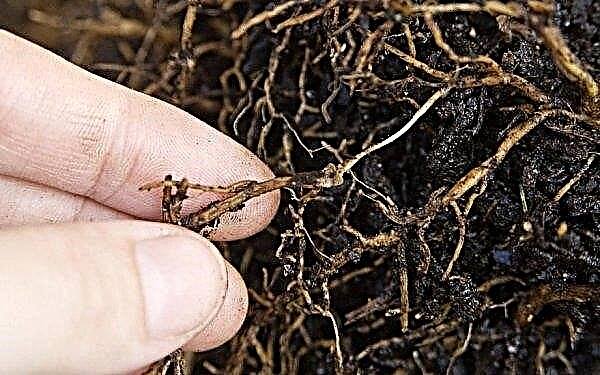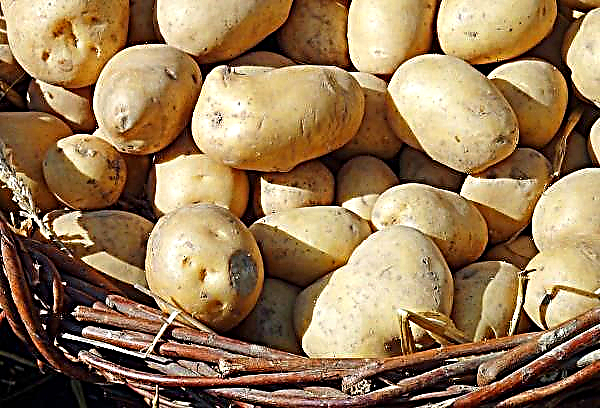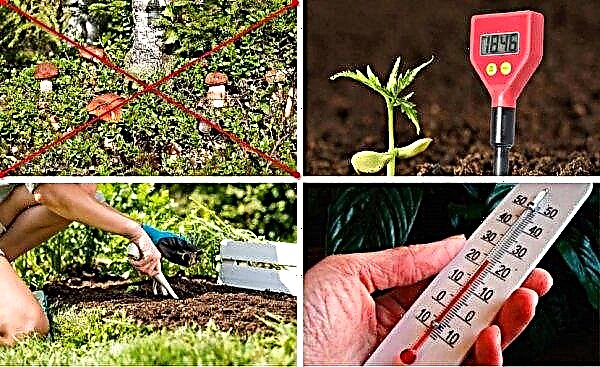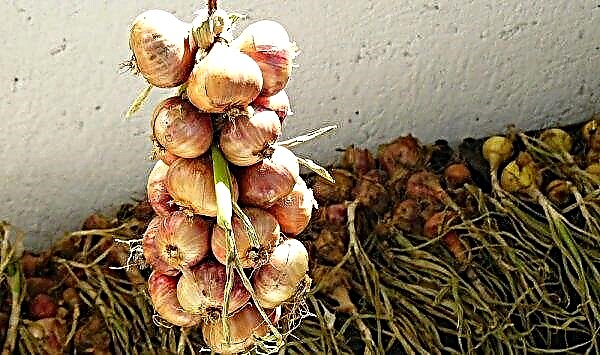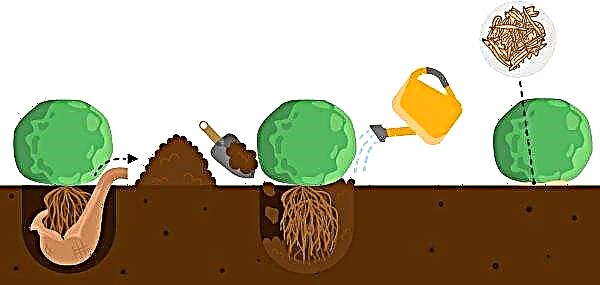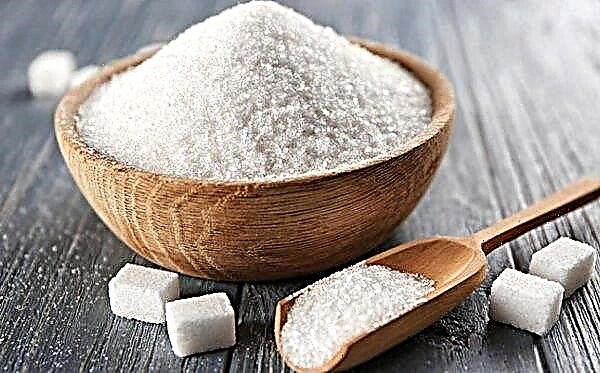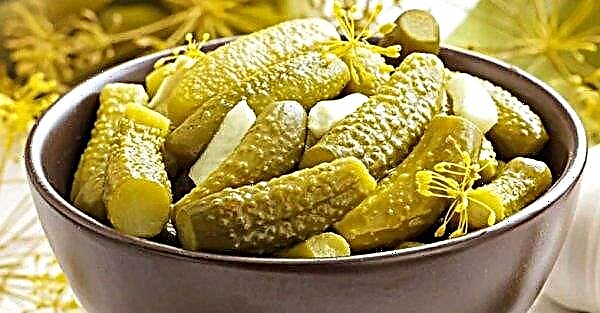A decorative pond serves not only as a decoration of a garden or a summer cottage, but also as an environment for many species of plants and animals. In order for the water kingdom to maintain an attractive appearance and create favorable conditions for the life of its inhabitants, it needs to be regularly looked after. The following recommendations will help ensure proper care.
Spring care
In early spring, when the snow has completely melted, it is necessary to prepare a reservoir for the beginning of a new season. During the winter period, a large amount of silt forms at the bottom of the pond, the pH level of the water changes, the bottom may crack, the edges are overgrown with wild shrubs, and water is polluted. Given these factors, spring care involves preventive and cleaning work.
Did you know? Organic garbage collected in a reservoir can be used as fertilizer for plants.
Cleaning includes the following activities:
- complete replacement of water;
- bottom cleansing;
- checking the bottom for cracks and other damage;
- seasonal pruning of shrubs growing on the banks of the pond;
- plant transplant.
 Next, you should study in detail the rules for cleaning the reservoir.
Next, you should study in detail the rules for cleaning the reservoir.
Pond cleaning
It is possible to determine that the pond needs to be cleaned by dipping a 10 cm white plate into it. If a dark slippery coating forms on the dishes, it is time to change the water.
Important! When cleaning the bottom of the sludge sucker, it is important to ensure that plants growing in the pond do not get damaged.
Step-by-step instructions for cleaning the reservoir:
- Catch aquatic plants, as well as all fish with a net. And to make it easier to do this, you can drain the water in half.
- Collect water from the pond into the tank and temporarily place livestock in it. It is important that the fish at the time of cleaning were in their usual environment.
- Drain the remaining water, then remove the rotted algae and other plants.
- To clear a bottom of silt and dirt. To do this, you can use a special vacuum cleaner or perform the procedure manually.
- Fill the pond with clean water.
- Run the representatives of the fauna. At the same time, it is necessary to pour water into the reservoir from the tank where they lived, so as not to disturb the ecosystem that is familiar to them.
The procedure is recommended not only in the spring, at least twice a year. This need is caused by contamination of water by silt, fish feed, as well as the waste products of the inhabitants of the pond. In mid-spring, you can run filters and fountains, if any.
Video: how to clean a pond
Plant transplant
Aquatic plants grow in containers filled with soil mixture. This is very convenient, as they can be moved as you wish, thereby forming bizarre compositions. Coastal plants are also planted in baskets in shallow water or near the pond. Spring transplantation of vegetation should be carried out at the stage of drainage of the reservoir during cleaning.
Rules for transplanting water plants:
- Plants should be replanted in late spring - early summer.
- Transplanting involves replacing the soil mixture in baskets.
- Before placing containers with vegetation in a reservoir, it is necessary to set them in shallow water for a while to allow them to adapt to the environment after wintering.
- The roots of floating plants (water lilies, duckweed) are formed in water, without soil, so their transplant involves moving from the aquarium in which they hibernated to the surface of the pond.
- The total amount of vegetation should be equal to half the surface of the reservoir. This volume is considered optimal for the interaction of plants, fish and microorganisms.
- Coastal plants need to be planted in containers singly, as they grow rapidly. Tanks with vegetation should be dug off the coast.

To transplant plants, you must remove them from the pots along with an earthen lump. Then wrap the container inside with burlap and fill it with a nutrient substrate intended for aquatic vegetation. Place a plant in it and sprinkle the topsoil with pebbles. Sacking and pebbles are needed so that the soil is not washed out in water.
Simple containers for flower pots are suitable as containers for growing plant inhabitants. Also in the spring it is necessary to cut the bushes growing on the shore of the pond. In this case, you need to leave only 20 cm from their length and try not to damage the young shoots.
Types of water plants:
- oxygenators: Elodea, swamp, buttercup, water moss. Plants that convert carbon dioxide to oxygen. Contribute to aeration of a reservoir;
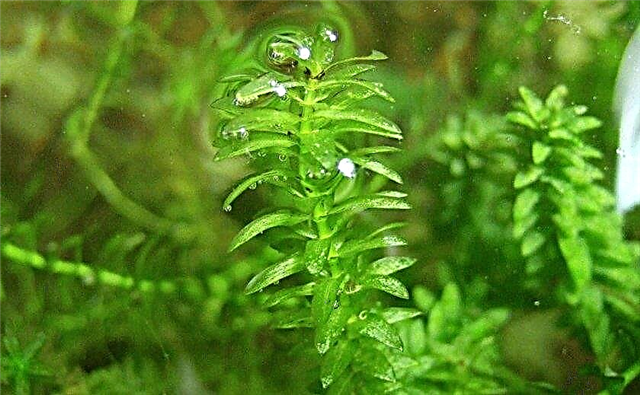
- deep-bottom: water lily, egg capsule, Brazil. They feed on organic waste, thereby purifying the water in the pond and maintaining the balance of the ecosystem;
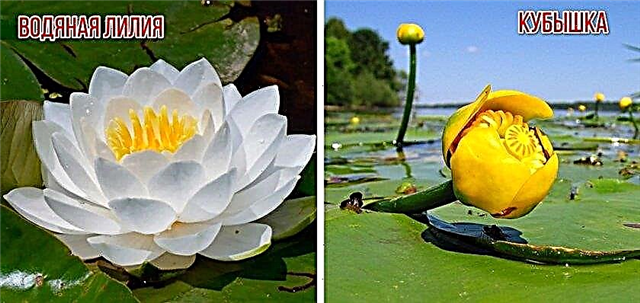
- floating: duckweed, handgun, flyer, azolla. Rooted in water and float freely on the surface of the reservoir. They grow very quickly, so they need to be thinned regularly;

- marsh: cattail, sedge, chastukha, kaluzhnitsa. They grow in the coastal zones of the pond and visually smooth the transition of the coast to the water surface;
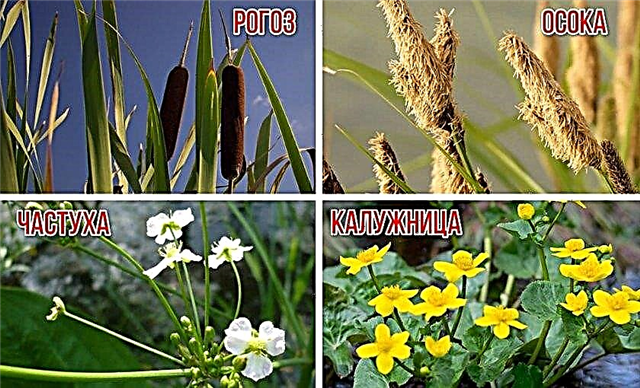
- coastal: host, buzulnik, daylily, dawn. They grow along the coast, forming green thickets that fit perfectly into the general concept of a decorative pond.

Summer pond care
With the advent of summer, as a result of exposure to high temperatures in the reservoir, the risk of certain problems increases. They can be solved only by carrying out constant care and observing the state of water in the reservoir.
The most common problems that occur in the summer:
- decrease in water level;
- the appearance of pests;
- sprouting of weeds.
Water level
As a result of intense exposure to sunlight, the water level in an artificial reservoir may decrease. If this happens, water must be added as it evaporates. If this is not done, the lack of sufficient water space can adversely affect the development of plants and the quality of life of fish living in the pond. The risk of waterlogging is also likely.
Pest control
In order to protect the water kingdom from the invasion of pests, it is not recommended to place it near horticultural crops, since it is from them that insects get into the water. It is also necessary to periodically conduct sanitary pruning of coastal plants, removing dry and damaged shoots on which parasites can settle. It is necessary to remove garbage from the bottom and plaque from the walls of the reservoir in time to prevent the propagation of pests.
Insect parasites living in water bodies:
In most cases, pests that have fallen into the pond can be eliminated by running various types of fish into it. Parasites that live on the surface of leaves (aphids, water lily leaf beetles) can be removed by removing the damaged plant. To get rid of caddis, you have to completely clear the bottom of the sludge.
The houses on which the eggs of the butterfly fire fly, you need to catch a net. In a clean pond, parasites do not multiply, therefore, in order to avoid unnecessary trouble, it is strongly recommended that they be carefully looked after.
Weed cleaning
Weeds growing on the shore of the pond, as well as aquatic plants, abundantly braiding its surface, significantly spoil the appearance of the reservoir and interfere with the development of other plants. It is recommended to thin out floating water lilies and duckweed from time to time.. Weeds should be removed with roots and regularly weed along the coastal area. This must be done not only in the summer, but throughout the year.
Autumn care
With the advent of autumn, the hassle of maintaining a reservoir in the country does not become less. Gradually the leaves fall and the shoots of coastal plants dry out. Aquatic vegetation requires top dressing and the creation of suitable conditions for wintering. At this time, in addition to the usual care, additional efforts will have to be made to prepare the water world for the rest period. To do this correctly, a few tips below will help.
Leaf cleaning
Foliage, as it falls, needs to be collected from the surface of the water using a net. It’s easier to remove leaves from the shore. To do this, you can use the garden rake and rake the yellowed leaves with them, forming heaps. It is undesirable to burn them, since the smoke of burning leaves is very toxic. It is much more environmentally friendly and more convenient to move heaps into garbage bags. Then throw them into the trash can.
Important! Fallen foliage must be caught from the reservoir. Settling to the bottom, it begins to rot, which significantly pollutes the ecosystem.
Pruning plants
In addition to cleaning fallen leaves, you need to pay attention to coastal plants. In the autumn period, they must be trimmed, removing dry and damaged branches. This measure will protect the vegetation from the appearance of diseases and pests that winter on their surface. Also, shortening the overgrown shoots will give the plant the opportunity to relax and accumulate the necessary forces for the vegetation. Annuals should be cut out completely. In the fall, all branches are pruned, while 10-15 cm from their length should be left.
Also, shortening the overgrown shoots will give the plant the opportunity to relax and accumulate the necessary forces for the vegetation. Annuals should be cut out completely. In the fall, all branches are pruned, while 10-15 cm from their length should be left.
Collection of wintering buds and thermophilic plants
Measures to prepare for winter depend on the winter hardiness of varieties of aquatic vegetation.
Types and winter hardiness:
- frost resistant: kalugnitsa, hosta, aquilegia, cotton grass, water lily, elodea, vodokras, duckweed, calamus. These plants are best left to winter in the wild. Collect sleeping buds for storage in the winter is not required. However, it is necessary to transfer all plants to an impermeable depth;

- thermophilic: egg capsule yellow, swamp, cattail. Containers with plants need to be cleaned for winter storage. Keep in a bright warm room at a temperature of 0 ° C. Store sleeping kidneys in an aquarium at room temperature.

In the spring, after awakening, the young shoots will sprout buds both in vivo and in the aquarium. In the latter case, after the weather is warm, it will be possible to transplant into a reservoir.
Feeding the inhabitants
In autumn, before the water temperature drops to + 9 ° С, fish can be fed with natural food rich in proteins and microelements. Insects such as bloodworms and midges are suitable for this. You can also feed worms. After the onset of the first frosts, it is necessary to stop the feeding and place the aquatic inhabitants in the aquarium.
At the same time, it is important that it be filled with water from a reservoir in order to preserve the habitual habitat. Then it is advisable to install an aquarium light and water heating. Fertilize vegetation is also necessary in the autumn, before harvesting for winter storage. To do this, special fertilizers for aquatic plants should be introduced into the soil.
Winter
In winter, when a stable air temperature is set below -10 ° C, it is necessary to provide suitable conditions for the reservoir and its inhabitants.
Winter care includes:
- providing oxygen to fish;
- heating water in a reservoir to the optimum temperature;
- draining.
It is important to responsibly treat the requirements for winter care, since the life and health of the inhabitants of the reservoir, as well as its condition as a whole, depend on this. Otherwise, in the spring it will be necessary to eliminate the consequences, which will add to the trouble of maintaining the pond.
Video: how to make an ice-free pond in the garden
Access to oxygen for fish
Fishes that hibernate under natural conditions need to provide oxygen. This must be done so that gas exchange continues in the aquatic environment. Besides, waterfowl vital air. Its receipt can be provided by installing aeration equipment.
Did you know? To protect the walls of the pond from the formation of plaque, you can run snails into it. They will feed on organic deposits on the surface, which will reduce the risk of pests.
If there is none, you can make an ice hole in the ice. But one must act with extreme caution so as not to injure the fish that swim on the surface of the water in search of oxygen, and the roots of plants wintering in the pond.
Heated water in the pond to the optimum temperature
With the onset of frost, the water in the pond must be additionally heated. This is necessary to ensure the normal functioning of the fauna, which, as you know, are cold-blooded and can not warm themselves. Also, sleeping buds that have remained for the winter in a pond of plants need warmth. Despite winter hardiness, low temperatures can adversely affect their condition. For heating, you can use a special heating system. If there is no such equipment, it is recommended to collect the fish together with plants and send them for wintering at home.
Despite winter hardiness, low temperatures can adversely affect their condition. For heating, you can use a special heating system. If there is no such equipment, it is recommended to collect the fish together with plants and send them for wintering at home.
Draining
Deep water should not be drained. The bottom of such ponds does not freeze, which provides their inhabitants with a comfortable wintering. More shallow artificial lakes will have to be drained, as the ice will bind the entire body of water. Animals in such conditions will not survive, and the bottom may crack due to the expansion of the ice mass.
To drain the pond, you need to completely drain the water, clean the bottom of the layer of sludge and dirt, then clean the walls of plaque and remove rotted algae. In this case, plants and fish are caught by the net (it is recommended to leave a third of the water in the bowl of the reservoir) and place them in the home for the winter period. Keeping an artificial pond in the country is quite easy. However, in the absence of proper attention and care, it can quickly turn into a swamp. Pond cleaning should be done seasonally, as each season of the year has a different effect on its condition.
Keeping an artificial pond in the country is quite easy. However, in the absence of proper attention and care, it can quickly turn into a swamp. Pond cleaning should be done seasonally, as each season of the year has a different effect on its condition.












